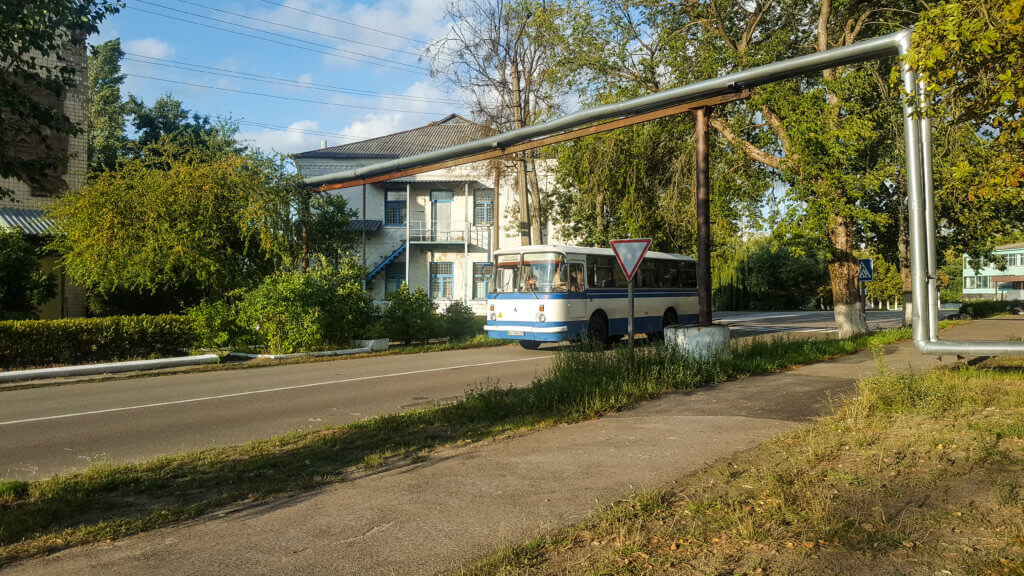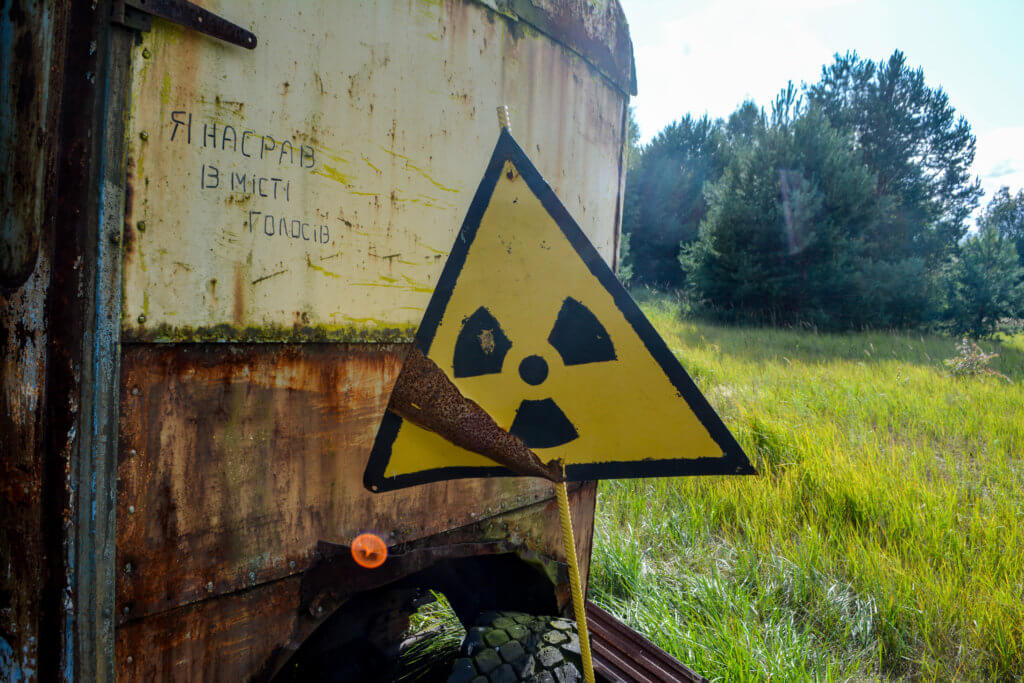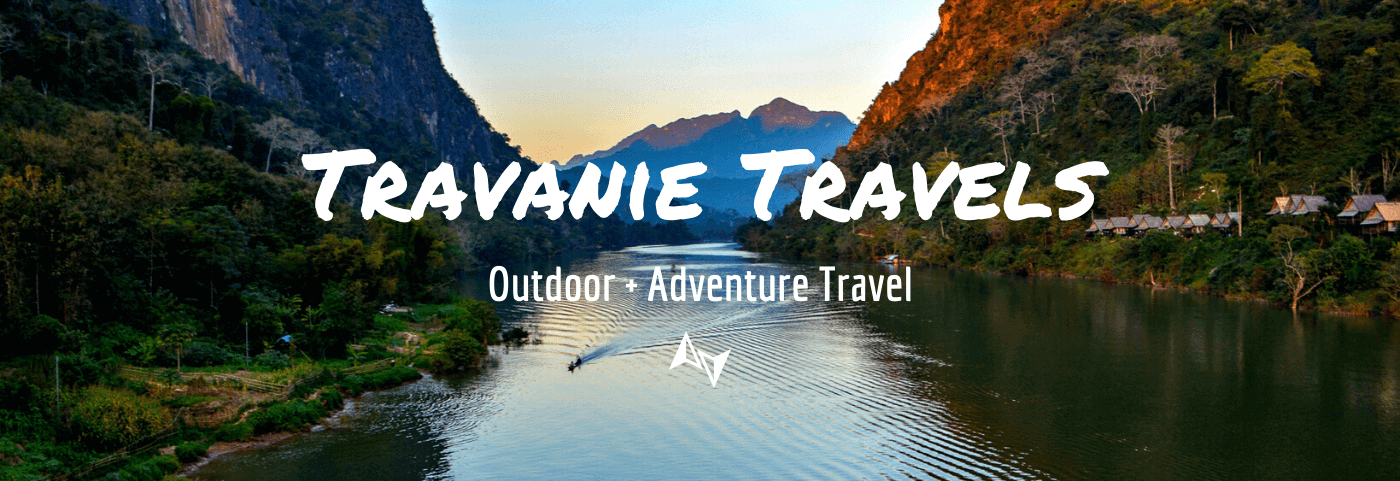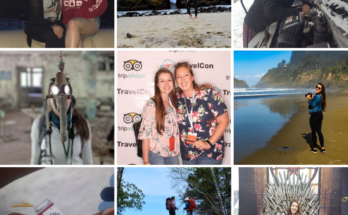Visiting the Chernobyl Exclusion Zone wasn’t as scary as I expected.
After all the stories, documentaries, and articles I read about the disaster at Chernobyl, I expected tragedy to hang in the air, to loom on my conscious, and even to make my stomach ache as I confronted the physical remains of the disaster that occurred 33 years prior.
I anticipated feeling the fear, pain, and apprehension of the 100,000 displaced citizens, 200,000 heroic liquidators, and countless generational victims affected by the nuclear fallout. I expected three days filled with horror and heartbreak; I felt ready to be personally impacted and transformed by the real, raw, and emotional experience of visiting a radioactive ghost town.

But crossing into the exclusion zone, I didn’t feel anything. No weird twinges; no mysterious pangs of emotion; no fear. I didn’t feel different as I handed over my passport to a stern military official or as I signed away my rights on various health and safety waivers. Even as I walked past the armed guards and across the painted line that separated the “safe” outside world from the “dangerous” exclusion zone, I felt nothing.

I waited for some sort of sensation of danger or apprehension as we drove through the 30 kilometer zone and then again when we passed through the military checkpoint at the 10 kilometer zone entrance. Even as I stood a mere 200 meters from the actual disaster site with its granite memorial and shiny new sarcophagus, I felt nothing. I couldn’t summon any recognition of reality.
I struggled to pinpoint the source of my numbness since I’m typically an emotional traveler, especially at dark tourism sites. Was it the disbelief of finally standing in the exclusion zone after years of anticipation? Maybe it was the contrast of a perfect, sunny day and the dark, tragic events that occurred where I stood? Or perhaps it was the absence of any tangible danger of radioactive exposure? It was likely a combination of all three – potentially more.
Over the course of my three days and nights in the Chernobyl Exclusion Zone my thoughts and emotions became even more convoluted as I experienced life in the exclusion zone first hand and learned more about its complexities.

Exploring in the Exclusion Zone
For three days, our guide, Nasar, escorted us in and out of the exclusion zone’s most iconic landmarks, like the hospital and amusement park in the city of Pripyat, as well as secretive, off-the-beaten-path locations hidden throughout the zone including a dentist office, bus station, and a children’s summer camp.
After seven years of leading tours in the nuclear exclusion zone, Nasar provided us with uncontested expertise and knowledge about any and all Chernobyl topics including Pripyat history, Ukrainian culture, Soviet life in the Eighties, modern scientific experiments in the zone, the HBO Chernobyl mini-series, and more. He knew absolutely everything about everything and whenever we got quiet, he would prod us for more questions.

With Nasar’s guidance, we explored the deteriorating remnants of many facets of daily life in Pripyat and the surrounding countryside. Some of our stops around the former utopian city included sports clubs, kindergartens and grade schools, grocery stores, art and theatre centers, boat houses, coffee shops, hospitals, fire stations, apartment buildings, a brand new football stadium, a piano store, and so much more. We also learned about the Soviet occupation and military efforts in the Cold War as we explored a Soviet military base and the infamous Duga Radar System – which was a complete secret from the West until the disaster.

Of all our stops within the zone, our day exploring Pripyat definitely felt the most impactful. It felt so surreal to stalk around an abandoned city of a former 50,000 inhabitants and not see another soul. It felt even stranger to stand in the middle of the city’s main square and hear nothing but the wind in the trees. At one point as we walked along a path through the forest, I looked up and saw a street light perfectly camouflaged amongst the trees. Only then did I realize we’d been walking down a once two lane street.

For the most part, the rapid forest reclamation of Pripyat made it easy to forget about the real people who lived there before their lives were uprooted. If I didn’t actively think about it, I found myself forgetting where I stood and the life-changing disaster that happened there.

However, whenever we saw a personal artifact I started to feel those sickening twinges of reality sinking in: a single shoe, a coat on a door knob, a framed photo on the windowsill, or a carton of milk still sitting on the kitchen table. The generic signs of former life like grocery carts, medical equipment, furniture, or propaganda posters didn’t evoke the same emotional reaction. However, the personal and intimate artifacts served as a sombering reminder of the people, the real people, that lived there and once had lives similar to mine. That’s when the experience became heavy and grim.

Daily Life in the Exclusion Zone
In stark contrast to the ghost towns in the 10 kilometer zone, our evenings in Chernobyl town seemed suspiciously normal and mundane for an area in the shadow of the world’s worst nuclear disaster.

We ate traditional Ukrainian meals at Chernobyl’s only restaurant and stocked up on snacks (and vodka) at its only convenience store. Our humble hotel provided hot showers and we even had access to reasonably fast wifi. We also learned of a fully functioning post office, basic health clinic, and fully stocked bar that served to entertain its residents.

Each evening as we returned back to Chernobyl from our day’s exploring, I loved watching as daily life for the exclusion zone’s 500 or so residents unfolded. A public bus system shuttled government workers from their job site to their issued apartments. A group of military officers gathered outside of the Roadside Picnic convenience store to toss back a couple beers and bullshit after a long day. The hotel staff chatted as they hung laundry on the clothesline to dry and the restaurant’s chef peeled potatoes on the porch.
Other than the strict 9:00 PM curfew and eerie quiet after dark, it felt like we could have been in any normal small Ukrainian village. Laying in my hotel bed listening to the wild dogs howl, I had to keep reminding myself of my location.

Meeting a Chernobyl Self Settler
On our final day, Nasar arranged for us to visit one of the exclusion zone’s estimated 135 self settlers. This added a new element of complexity to the already complicated thoughts and opinions I began to develop about Chernobyl.
Self settlers are identified as people who originally refused to leave their homes during the evacuations or who moved to the land within the exclusion zone in the years after the disaster. Today, most settlers live a quiet life off-the-grid and survive with very little outside assistance or human contact – only annual government check-ins and the occasional tourist visit.

Vasily, the youngest self settler in the exclusion zone at age 63, and his wife welcomed us into their home with beaming smiles. They served us a delicious breakfast of fried eggs from their chickens, pickled tomatoes from their garden, raspberry preserves on freshly fried doughnuts, homemade alcohol, and so much more. We were their second visitors of the entire year and they were so excited to host us.

For nearly four hours, the six of us sat at Vasily’s outdoor patio table as Nasar translated our conversations about Vasily’s life, opinions, and plans for the future. We laughed, joked, and bonded over many, many shots of vodka.

Vasily gave us a full tour of his home and property. We followed him around his garden watching has he pointed out the different types of fruits, vegetables, and herbs he grew – none of which showed any signs of deformity. We met his livestock, learned about their sustainable living practices, and looked through some photos of his former wives and life in Kiev.

Overall it felt impossible to even comprehend the reality of where I stood in relation to the rest of the world. I knew I was in a “dangerous” place deemed unsafe for human life. However, in the bubble of Vasily’s colorful home and vibrant garden it was hard to keep the danger of radiation top of mind as we smiled, laughed, and shared an unforgettable cultural experience.

Sitting with Vasily in the countryside of the nuclear exclusion zone, uncomfortably full and pleasantly buzzed, I grappled with the complexity of Chernobyl. After my brief time there, I already viewed the exclusion zone as more than just a disaster site. Through our experiences we had seen it as a workplace, a home, a scientific test site, and a tourist destination.

Final Chernobyl Reflections
My three day tour in the Chernobyl Exclusion Zone changed me – but not in the way I expected. Instead of only focusing on the disaster and its tragic aftermath, I became more alert of the complexity and intrigue of this unique place. There literally isn’t anywhere else in the whole world quite like it – thankfully.
I expected to feel afraid, disgusted, and completely outraged during every minute of my time in the exclusion zone. I did feel all those emotions – but I also felt so much more as my understanding of the world, history, and human resilience became broadened and challenged with each new experience and story.

Chernobyl represents more than a horrific disaster site, it’s also the pioneer of nuclear disaster and radiation research, a home for previously-displaced self settlers, a workplace and well-paying job for Ukrainian citizens, tourist income for a developing nation, and a means of first-hand education and awareness about the dangers and repercussions of nuclear power.
Instead of leaving Chernobyl with a more detailed version of its disastrous history, I exited the exclusion zone with a deeper comprehension of its dark past, complex present, and ever-evolving future.
For all these experiences, I am very grateful.




Well written and I think the photography was perfect for bringing the ideas being shared in the text alive.
Thank you! 🙂 I’m glad you enjoyed it!
You’re a really great writer, especially with articulating your emotions in regards to the deserted and somber area. I love that you were able to meet with a local – they seemed so sweet.
Thank you so much Lauren – it really means a lot! 🙂 It was an unforgettable experience – the self settlers were some of the kindest, most enthusiastic people I’ve ever met!
STEPH! Your writing is absolutely fantastic. I thoroughly enjoyed every word, every description, and every thought you conveyed to us. What an experience. I seriously can’t wait to read more of your adventures (and not just because I already know you’re awesome)!!!
TARA! thank you so much for reading & your kind words! It really means so much to me 🙂 I am so glad you enjoyed my story & can’t wait to write more for you to read!